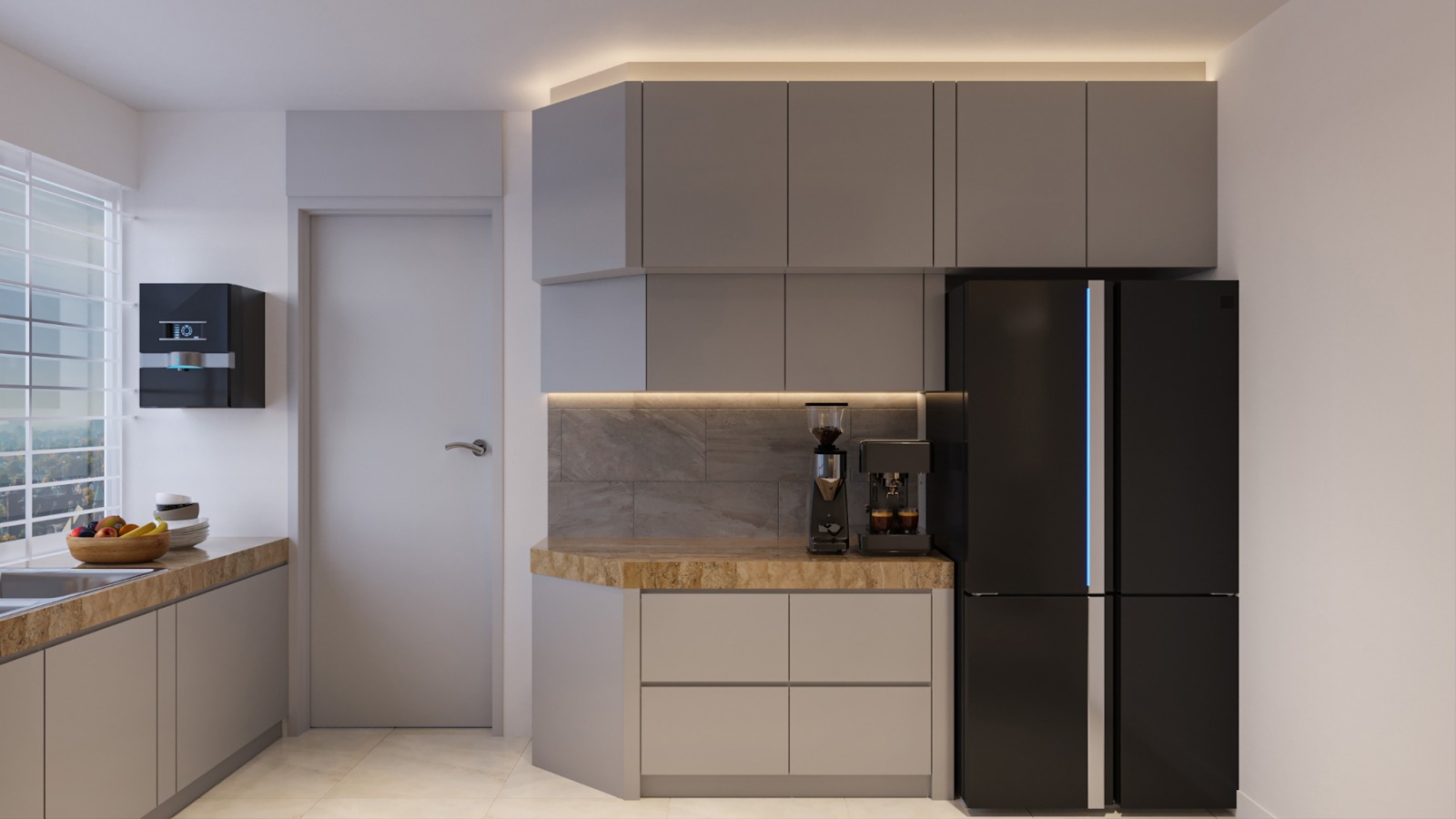Here’s a sobering fact: the average American dedicates about 37 minutes each day to kitchen cleanup, which totals more than 200 hours every year. Think about what you could do with that time instead. Learn a language? Finally finished that novel? Stop wasting precious hours battling grease and grime.
The secret to reclaiming your life is designing smarter from the start. These kitchen design tips will show you exactly how to build a space that looks stunning while demanding almost nothing from you maintenance-wise.
Once you grasp how strategic design decisions can hand you back entire weekends, we can jump into what makes any low maintenance kitchen actually work: choosing materials that don’t quit on you.
Tip 1 – Select Durable, Stain-Resistant Materials for High-Traffic Surfaces
Your material selections will either become your best friends or your worst enemies. Pick wisely now, and you’ll barely lift a sponge later.
Countertop Materials That Stand the Test of Time
Want to know the secret weapon in easy kitchen renovation planning? Quartz countertops, hands down. Their non-porous nature means liquids just sit there waiting for you, no panic-inducing race against permanent wine stains. You’ve got time to grab a paper towel.
Porcelain surfaces? They’re equally impressive, plus they laugh in the face of scorching hot pans placed directly on them. Then there’s Corian and similar solid surfaces that install without seams, which means goodbye to those irritating gaps where mysterious crumbs take up permanent residence.
Creating Flow Beyond the Kitchen
Look, your kitchen doesn’t exist in isolation. Consider how it connects to where people actually gather and eat. A round dining table set positioned thoughtfully creates a natural transition between your cooking zone and where everyone congregates, making the entire space feel intentionally designed rather than accidentally arranged. This smart layout strategy keeps foot traffic from constantly cutting through your prep areas, which translates to fewer opportunities for spills and tracked-in mess.
Smart Flooring Options for Minimal Upkeep Kitchens
Luxury vinyl plank (LVP) flooring is durable, water-resistant, low-maintenance, and realistic-looking. Think of it as the kitchen floor equivalent of a reliable old friend who never lets you down. Porcelain tile comes in second place, delivering unbeatable toughness without making your wallet weep like natural stone does.
Maybe you’re feeling those contemporary vibes? Sealed concrete delivers that raw, industrial aesthetic while asking remarkably little from you upkeep-wise. One crucial warning, though: natural hardwood in kitchen spaces is asking for trouble. Sure, it’s gorgeous until it’s not.
Backsplash Solutions That Resist Grease and Grime
Large-format tiles are about to become your new obsession. Why? Fewer grout lines equal dramatically less scrubbing. That’s just math. Glass backsplashes? One swipe and they’re spotless. Stainless steel brings restaurant-grade durability into your home. And nano-coated surfaces represent the cutting edge of “I can’t believe nothing’s sticking to this” technology.
Now that you’ve got bulletproof surfaces protecting your kitchen’s bones, let’s talk about appliances that basically take care of themselves.
Tip 2 – Choose Appliances With Self-Cleaning and Smart Technology Features
Today’s appliances don’t just cook your food; they actually maintain themselves. This is where functional kitchen design collides beautifully with technology that works for you.
Energy-Efficient Appliances That Clean Themselves
Self-cleaning ovens employ pyrolytic or catalytic processes to incinerate stuck-on food residue. Translation? You’re done scrubbing fossilized cheese forever. Modern dishwashers with self-cleaning filters? They eliminate that disgusting monthly chore everyone avoids.
Can we discuss induction cooktops for a second? Their completely flat surfaces wipe clean in literally seconds, and nothing can bake onto the glass because it stays cool. For families who actually use their kitchens, this changes everything.
Smart Kitchen Technology for Automated Maintenance
IoT-enabled appliances ping your phone with maintenance reminders. Self-diagnosing systems warn you about potential problems before they become catastrophically expensive. Touchless faucets cut down on water spots and bacteria accumulation, keeping the sink area respectable between proper cleaning sessions.
Fingerprint-Resistant Finishes and Coatings
Black stainless alternatives and smudge-proof finishes maintain that fresh-from-the-showroom appearance. Matte finishes hide fingerprints infinitely better than glossy options, though a strategically positioned glossy backsplash can paradoxically make cleaning faster.
Smart appliances slash cleaning time dramatically, but even space-age technology can’t rescue a kitchen drowning in clutter. Let’s examine storage that stops mess before it starts.
Tip 3 – Implement Clever Storage Solutions to Reduce Clutter and Cleaning Time
Storage is often a top concern for homeowners planning kitchen updates. Thoughtful storage design isn’t optional; it’s essential for authentic minimal upkeep kitchens.
Closed Cabinetry Systems Over Open Shelving
Open shelving photographs beautifully for Instagram. In real life? It’s a dust magnet. Closed cabinets equipped with soft-close mechanisms protect your dishes while eliminating daily dusting marathons. Full-overlay doors create sleek, continuous surfaces that wipe down effortlessly.
Pull-Out and Drawer-Based Storage Innovations
Deep drawer systems let you grab what you need without contorting yourself or excavating through stacks. Pull-out pantries keep ingredients visible and organized. Corner cabinet solutions squeeze functionality from awkward spaces, while trash drawer systems completely conceal waste management.
Vertical Dividers and Custom Inserts
Plate racks prevent chipping while maintaining accessibility. Utensil organizers assign everything a home. Spice drawer inserts with alphabetized slots mean you’ll stop accidentally buying your third jar of cumin.
Organized storage cuts cleaning time substantially, but hidden dirt traps lurking in seams and grout lines can sabotage everything. Here’s how seamless integration elevates your low maintenance kitchen.
Tip 4 – Design With Seamless Integration and Easy-to-Clean Joints
Integrated Sinks and Undermount Installation
Undermount sinks eliminate that annoying rim where debris gets trapped. You sweep crumbs straight into the basin without obstacles. Workstation sinks with integrated accessories consolidate food prep and cleanup into one efficient zone.
Minimize Grout Lines and Crevices
Large-format tiles think 24×48 inches or bigger, reduce grout exponentially. Rectified tiles permit tighter grout joints that seal more effectively. Sheet materials offer continuous coverage without any seams whatsoever.
Handleless Cabinetry and Push-to-Open Mechanisms
Integrated handle grooves deliver contemporary aesthetics with zero protruding hardware to clean around. Touch-latch systems remove handles entirely from the equation. Recessed pulls provide streamlined profiles while staying functional.
Seamless surfaces eliminate annoying crevices beautifully, but your color and finish selections determine whether daily wear broadcasts itself or disappears. The right palette becomes your secret weapon against visible chaos.
Tip 5 – Select Low-Maintenance Color Schemes and Finishes
Strategic Color Palettes That Hide Wear and Dirt
Medium-toned cabinets camouflage everyday wear infinitely better than pure white or black extremes. Patterned or textured finishes disguise minor imperfections. Multi-tonal schemes add visual depth while keeping everything looking presentable between cleaning days.
Matte Finishes vs Glossy Surfaces
Matte cabinet doors resist fingerprints remarkably well. Satin-finish countertops hide minor scratches that would announce themselves on polished surfaces. Strategic glossy backsplashes behind cooking zones wipe clean effortlessly, while matte cabinets stay pristine.
Protective Coatings and Sealants
Nano-ceramic coatings for countertops add another defensive layer. Cabinet door sealants provide moisture protection in steamy conditions. Don’t neglect grout sealing that annual maintenance prevents years of staining headaches.
Your Kitchen Maintenance Questions Answered
How much does designing a low maintenance kitchen actually cost compared to traditional kitchens?
Expect to invest roughly 15-25% more upfront for premium materials like quartz and LVP flooring. That said, you’ll recover this investment through reduced cleaning product expenses, fewer repairs, and massive time savings across the kitchen’s lifespan.
What’s the absolute easiest countertop material to maintain in 2024?
Quartz continues dominating the maintenance-free category. It never requires sealing, naturally repels stains, and cleans with nothing but soap and water. Porcelain slabs are legitimate runners-up.
Can I make my existing kitchen more low maintenance without gutting everything?
Definitely! Swap cabinet hardware for handleless alternatives, install a glass backsplash over the current tile, apply nano-coatings to existing countertops, and upgrade to a touchless faucet. These modifications create noticeable improvements without demolition.
Your Path to an Effortless Kitchen
Building the ideal low maintenance kitchen doesn’t mean compromising on beauty or performance. Smart material choices, self-sufficient appliances, intelligent storage, seamless construction, and strategic color palettes collaborate to slash your cleaning obligations dramatically.
Begin with just one or two upgrades today, perhaps that quartz countertop or those sleek handleless cabinets, and you’ll immediately feel the difference. Your future self will experience gratitude every single time you enter your kitchen and realize there’s absolutely nothing demanding your attention. That freedom? That’s the genuine luxury thoughtful design delivers.

